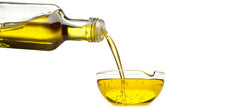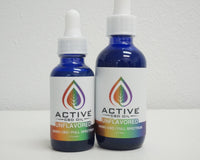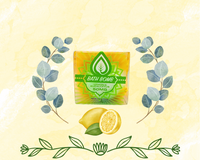Creating your own infusions with CBD isolate can be a great way to completely customize your CBD experience. Here we will include a simple recipe to create your own CBD topical using our Active CBD oil Isolate.
CBD Oil Uses
Many people are using CBD oil today, and considering how it is non-toxic and doesn't produce any adverse side effects in the user there has been a huge amount of interest. Using this form of CBD gives you all the benefits of cannabidiol without having to worry about THC content which can cause impairment.
So, if you are considering using CBD topicals but don't know where to start then here are some guidelines you should follow when making up your own topical lotion with CBD isolate.
The first thing that you should do when looking into making your own CBD cream or CBD oil for pain relief is determine what kind of base you want to use because not every type of base will work correctly with CBD. For example, if you are using a CBD cream that is water-based then it will absorb into the skin much better.
The reason for this is because CBD topicals are oil based products which means they don't mix well with water. On the other hand, an oil-based topical cream will leave the user feeling greasy since CBD topicals are made up of oils themselves. So, to avoid any problems with CBD absorption it's best to use a base that is not only compatible but also works well with cannabidiol so it doesn't degrade its properties either.
When deciding on what type of base to go for you should always pick one that has been made specifically for making topicals and not something that you use for your regular skincare routine.
Using the wrong base can make CBD behave unpredictably which will ultimately lead to a sub-optimal experience.
This is not to say you shouldn't make topicals yourself at all but rather be extremely careful what kind of base you are using since CBD oil isn't always compatible with many product bases.
Cannabidiol Topical Bases
When it comes to choosing a cannabidiol topical base there are several choices, each having their own merits and drawbacks.
For example, if you want to avoid any greasiness or stickiness then an oil based cream or lotion is probably the best choice for you because it will absorb into the skin much than other types on the market.
Oil base topical lotions and creams are perfect for those looking for both relief from pain and more healthy skin as well. However, if you don't want to deal with an oily or greasy CBD topical then a water based cream or gel might be the right choice for you.
Water-based CBD topicals work by infusing CBD into water and mixing it with other ingredients before adding it to any kind of cream base. They're mostly free of CBD impurities since the only potential additive is some kind of organic solvent but this is not always necessary. The benefit here is that they can easily be absorbed into the skin, allowing them to deliver their benefits much faster than oil-based which take longer due to having to be absorbed through the skin. However, since they are water-based CBD topicals are not as effective at treating pain as their oil-based counterparts due to how quickly they're able to absorb into the blood stream. The drawbacks don't end there either since CBD topicals that are made up of mostly water can contribute toward making your skin more oily over time.
With all this being said it's best to decide what kind of base you want before beginning any kind of CBD topical so you have a good idea what you should be looking for when it comes time to buy or make one. While not every type is perfect for delivering cannabidiol, each has its own unique attributes which allow them to excel in one area more than another. For example, CBD oils and gels are perfect for those looking for skin benefits as well as pain relief while water-based lotions and creams work best when you want pain relief without having your skin greasy or oily afterward.
Creating a CBD topical base oil is one way that CBD oil companies can make money while meeting end users' needs. One of the first CBD topical base oils was 300mg CBD Vape Oil. This additive is designed to be added into any vape, and since it has no flavor, can be used with any type of e-liquid (for those that like sweet flavors) or even with unflavored vape juice. The oil can be added to your normal vape equipment, just like e-liquid. It comes in different flavors, including CBD citrus flavor and CBD menthol flavor.
CBD has been proven to work in topically applied creams and cannabis salves for pain relief in illnesses such as arthritis . CBD is also known to reduce inflammation , which is why it is often used in muscle pain relief creams. This makes cannabis infused oil an ideal candidate for CBD topical base oil.
Don't have time to make your own CBD topical? Leave it to the professionals and check out our CBD topical collection.





-
Grapeseed Oil
-
Olive Oil
-
Coconut Oil
Now that you have the basic recipe down, you can further customize your CBD salve by adding different essential oils (like sweet almond oil, jojoba oil, tea tree oil, infused coconut oil), different ratios of other base oils, as well as adding other cannabinoids such as CBG. For example, to turn this infused oil into a better cannabis salve recipe, all you would do is melt and stir in a little beeswax after step 5 and also add essential oils. Most people prefer a ratio of 1 part beeswax to 4 or 5 parts oil, if you decide to go this route.
You can even experiment with custom potency formulations, with the help of our "Confused by the Math?" Blog.
For more CBD isolate recipes, check out our full list of recipes Here: CBD Isolate Recipes.
Interested in making a tincture to take internally, instead of a topical? See the companion post to this blog, Adding CBD Isolate into a Larger Base (Tincture).
F.A.Q.
How to add CBD Isolate into a topical?
CBD Isolate is known to be safe and non-toxic. You can add CBD isolate into your skin care products in the same way you would add any other active ingredient like glycerin or Vitamin E.
How much CBD Isolate add into a topical?
To add CBD Isolate into a topical, such as a cream or butter, you will need to determine the best ratio of CBD Isolate to carrier. The ratios below can be used for most creams and butters: 0.25 -1 gram grams of CBD Isolate per ounce of cream/butter.
Although not necessary, the higher the concentration of CBD Isolate in your topical, the faster you can expect relief from your symptoms.
Why is CBD Isolate adding into a topical?
For a lot of individuals, there is no other product in the world that comes close to the effectiveness and convenience of CBD Isolate. Why does this matter? Because it makes it incredibly easy for you to add CBD Isolate into your favorite topical products.
All you need to do is melt down your chosen base (cocoa butter, shea butter, or any other similarly slow-melting vegetable oil) and then whisk in the CBD Isolate crystals until they're thoroughly combined. Shelf life will vary depending on your mix, but you're probably looking at anywhere from 6 months to 2 years of effective shelf time before the cannabinoids begin to degrade.
What are the effects of CBD Isolate adding into a topical?
CBD oil can be consumed, but also added into topical products to take advantage of the therapeutic effects CBD has for the skin. Using CBD oil in a topical will enhance the effects of the product.
Much research is being done on the benefits that CBD has when topically applied to the skin, and the results are showing huge potential in alleviating problems people have with acne, psoriasis, seborrhea, atopic dermatitis, the aging process of the skin, etc.




























3 comments
Janet
As a novice to the CBD industry, I had questions due the measurements in preparation of adding in the isolates to the large base recipe that was quickly answered by Erin!
Amazing customer service!
Tracy
Thank you so much Erin for the recipe for making topical infusions with CBD isolate. I used coconut oil and look forward to using it tonight to ease the pain in shoulders and back.
Deborah Keezer
Thanks a bunch for the info. You’ve been very helpful. EDUCATION IS THE KEY!!!